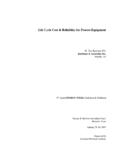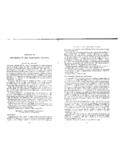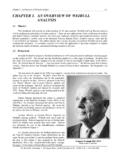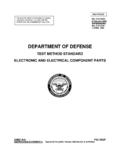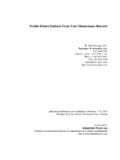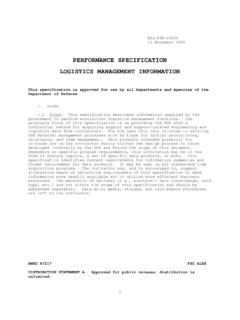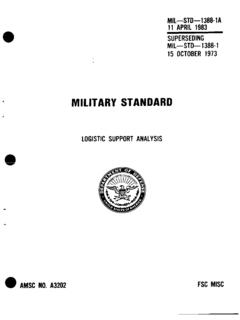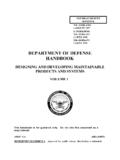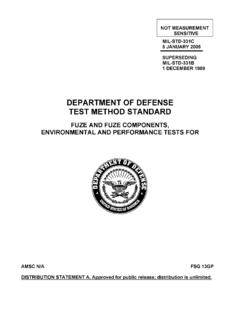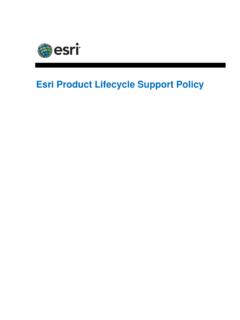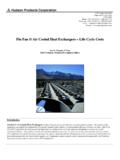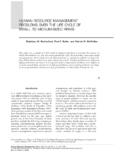Transcription of Life Cycle Cost Summary - Barringer1.com
1 A life Cycle cost Summary H. Paul Barringer, Barringer & Associates, Inc. Humble, Texas USA. International Conference of Maintenance Societies (ICOMS -2003). Sheraton Hotel Perth, Western Australia AUSTRALIA. May 20-23, 2003. Presented by Maintenance Engineering Society of Australia, A Technical Society Of The Institution of Engineers, Australia Page 1 of 10 ICOMS-2003. A life Cycle cost Summary H. Paul Barringer, , Barringer & Associates, Inc., Summary : life Cycle costs (LCC) are cradle to grave costs summarized as an economics model of evaluating alternatives for equipment and projects.
2 Engineering details drive LCC cost numbers for the economic calculations. The economics of proposals drives the scenario selection process. Good engineering proposals without economic justification are often uneconomical. Good engineering with good economics provide business successes. The LCC economic model provides better assessment of long-term cost effectiveness of projects than can be obtained with only first costs decisions. Keywords: life Cycle cost , net present value, lowest long term cost of ownership, economics 1.
3 life Cycle cost DEFINITIONS. life Cycle cost is the total cost of ownership of machinery and equipment, including its cost of acquisition, operation, maintenance, conversion, and/or decommission (SAE 1999). LCC are summations of cost estimates from inception to disposal for both equipment and projects as determined by an analytical study and estimate of total costs experienced in annual time increments during the project life with consideration for the time value of money. The objective of LCC. analysis is to choose the most cost effective approach from a series of alternatives (note alternatives is a plural word) to achieve the lowest long-term cost of ownership.
4 LCC is an economic model over the project life span. Usually the cost of operation, maintenance, and disposal costs exceed all other first costs many times over (supporting costs are often 2-20. times greater than the initial procurement costs). The best balance among cost elements is achieved when the total LCC. is minimized (Landers 1996). As with most engineering tools, LCC provides best results when both engineering art and science are merged with good judgment to build a sound business case for action. Businesses must summarize LCC results in net present value (NPV) format considering depreciation, taxes and the time value of money.
5 Government organizations do not require inclusion of depreciation or taxes for LCC decisions but they must consider the time value of money. 2. INTRODUCTION. Procurement costs are widely used as the primary (and sometimes only) criteria for equipment or system selection based on a simple payback period. LCC analysis is required to demonstrate that operational savings are sufficient to justify the investment costs (often the investment costs, for the lowest long term cost of ownership, are greater than for the simple payback period).
6 Simple payback criteria are a relative measure for only one case. The more complicated LCC analysis works for comparing alternatives. The simple payback method is frequently used for small capital expenditures which are so clearly economical that the time and expense of a full LCC analysis is not worthwhile. Thus many companies demand short payback periods ( years) to keep everything simple with a large financial hurdle for a short time payback which discourages capital projects unless they are big winners. The payback method uses the ($capital cost )/($benefit/year) ratio as a screen for a single project alternative (it is not particularly useful for sorting out multiple alternatives with variations in cost profiles and variations in capital).
7 Remember the adage attributed to John Ruston: It's unwise to pay too much, but it's foolish to spend too little this is the operating principle of LCC. For capital expenditures above $10,000-$25,000 it is wise to consider the use of LCC. Procurement costs are only the tip of the iceberg but the damaging portion of the iceberg relates to the bulk of other costs associated with life Cycle costing for equipment and systems. 2 of 10 A life Cycle cost Summary ICOMS 2003. life Cycle cost was strong in the 1960s when LCC was the subject of considerable interest and publications.
8 Many original works on LCC are out of print. Newer publications are emerging such as: 1) RMS Guidebook (SAE 1995) for a life Cycle cost Summary , 2) Reliability and Maintainability Guideline for Manufacturing Machinery and Equipment (SAE 1999). for introducing details on how equipment survives and how it is restored to operating conditions as a method for decreasing life Cycle costs by way of both a strategy and tactics for how reliability tools, used up-front, can reduce costs and 3) life - Cycle Costing Manual for the Federal Energy Management Program NIST Handbook 135 (US.
9 Government 1995) for background and methodology for US Government calculations along with annual supplements for discount factors (US Government 2002). SAE advocates reducing life Cycle costs for equipment in the automotive sector by showing show/why reliability and maintainability must be included in upfront decisions for strategic and tactical issues of achieving the lowest long term cost on ownership. LCC concepts are resurging with US Government efforts to minimize energy costs. Remember this adage when considering LCC limitations: In the land of the blind, a one-eyed man is king!
10 LCC. improves our blinded sight we don't need the most wonderful sight in the world, it just needs to be more acute than our fiercest competitor so that we have an improvement in the cost of operating our plants. USA Department of Defense (DOD) tools and techniques are frequently used effectively in commercial areas and this is true of life - Cycle costing. Numerous references to LCC papers are listed in cumulative indexes for a major symposium (RAMS 2001). Major references for LCC in the DOD area are MIL-HDBK-259 for LCC details, MIL-HDBK-276-1 and MIL-HDBK-276-2 as form guides for details and for importing data into specific software.
